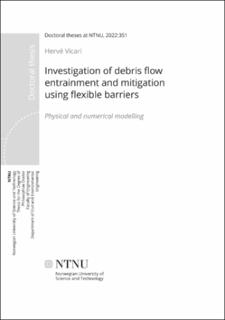| dc.contributor.advisor | Thakur, Thakur | |
| dc.contributor.advisor | Nordal, Steinar | |
| dc.contributor.author | Vicari, Herve | |
| dc.date.accessioned | 2022-11-04T12:25:29Z | |
| dc.date.available | 2022-11-04T12:25:29Z | |
| dc.date.issued | 2022 | |
| dc.identifier.isbn | 978-82-326-5199-3 | |
| dc.identifier.issn | 2703-8084 | |
| dc.identifier.uri | https://hdl.handle.net/11250/3030178 | |
| dc.description.abstract | Debris flows typically increase in scale by entraining soil, fluid, and boulders along the flow channel. Entrainment is typically modelled according to semi-empirical formulations which do not allow to capture the physical mechanisms of interaction between the flow and the channel bed materials. A 28m-long large-scale flume physical model and the Material Point Method were therefore adopted to study the debris flow entrainment and its mitigation.
An instrumentation was developed to measure entrainment of a 6 m-long wet soil bed built at the end of the flume channel. Flow velocities, flow depths, and entrainment were measured for release debris flow volumes of 2.5 m3 and 6 m3. Flow mobility and entrainment were interpreted based on the measurements of the flow basal stresses, which resulted in an average flow basal apparent friction of 9°, suggesting a high degree of flow liquefaction.
The Material Point Method (MPM) was adopted to back-calculate the test results. A one-phase elasto-plastic model was used to model the debris flow and the erodible bed materials. A softening model was introduced for the erodible bed to capture the effect of increasing pore pressures on the decrease of the apparent friction of the erodible bed. The numerical results show that a debris flow entrains the erodible bed by shearing the soil bed (basal scour mechanism) and by pushing the soil bed on surfaces normal to the flow direction (ploughing mechanism). The progressive reduction of the bed shear strength was captured. Weaker beds cannot resist gravity and are therefore easily entrained through a self-propelled entrainment behavior. Entrainment of stronger beds is dominated by the ploughing action of the debris flow. The simulation of the flume tests points towards the ploughing-enabled type of entrainment where the bed residual apparent friction is back-calculated to be 22.5°.
A special entrainment case was studied in MPM, where a boulder resting in the channel is hit by the flow front. The frontal boulder entrainment is found to reduce the flow mobility, proportionally to the mass of the boulder.
Flexible barriers were finally examined to study the mitigation of debris flows through entrainment reduction. An additional flume test was performed with an initial flow volume of 6 m3, where a compact flexible barrier was placed upstream of the erodible bed. In all the tests a terminal flexible barrier was also installed. The upstream barrier was observed to split the flow into two surges. The flow velocity after the barrier is reduced, and the smaller surges erode 70% less compared to the test without the upstream barrier. The impact on the terminal barrier is also reduced, resulting in a pile-up mechanism with a reduction of the impact force by 94% compared to the case without the upstream barrier. A run-up impact mechanism is instead observed for the compact upstream flexible barrier. A curvilinear overflow creates, which induces additional centrifugal forces normal to the slope and to the barrier. The multiple flexible barrier configuration examined in this work is found to be effective in reducing entrainment, flow velocity, and impact forces, as the flow propagates downstream. | en_US |
| dc.language.iso | eng | en_US |
| dc.publisher | NTNU | en_US |
| dc.relation.ispartofseries | Doctoral theses at NTNU;2022:351 | |
| dc.relation.haspart | Paper 1: Vicari, Hervé; Nordal, Steinar; Thakur, Vikas Kumar Singh. The Significance of Entrainment on Debris Flow Modelling: The Case of Hunnedalen, Norway. I: Challenges and Innovations in Geomechanics. Springer 2021 ISBN 978-3-030-64518-2. s. 507-514 | |
| dc.relation.haspart | Paper 2: Vicari, Hervé; Ng, C.W.W.; Nordal, Steinar; Thakur, Vikas Kumar Singh; De Silva, W.A. Roanga K.; Liu, Haiming; Choi, Clarence E. The effects of upstream flexible barrier on the debris flow entrainment and impact dynamics on a terminal barrier. Canadian geotechnical journal (Print) 2021 ;Volum 59.(6) s. 1007-1019 | |
| dc.relation.haspart | Paper 3: Vicari, Hervé; Tran, Quoc Anh; Nordal, Steinar; Thakur, Vikas Kumar Singh. MPM modelling of debris flow entrainment and interaction with an upstream flexible barrier. Landslides. Journal of the International Consortium on Landslides 2022 ;Volum 19.(9) s. 2101-2115 | |
| dc.relation.haspart | Paper 4: Vicari, Hervé; Tran, Quoc Anh; Nordal, Steinar; Thakur, Vikas Kumar Singh. MPM simulations of debris flow entrainment, modelling boulders explicitly.
This paper is not yet published and is therefore not included. | |
| dc.title | Investigation of debris flow entrainment and mitigation using flexible barriers. Physical and numerical modelling | en_US |
| dc.type | Doctoral thesis | en_US |
| dc.subject.nsi | VDP::Teknologi: 500 | en_US |

